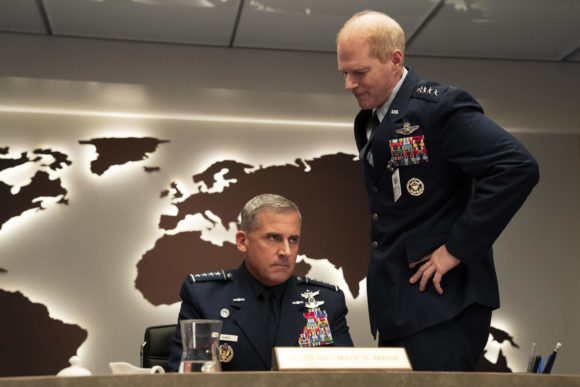Watching the sitcom Space Force for New Scientist, 2 June 2020.
As recruitment advertisements go, the video released to Twitter on 6 May was genuinely engaging. Young people stared off into the Milky Way, as rockets of indeterminate scale rolled out of unmarked hangers.
“Some people look to the stars and ask, ‘What if?'” drawled the voice-over artist. “Our job is to have an answer.”
This admirably down-to-earth sentiment was cooked up by the US Space Force, the most recently founded arm of the US military, officially brought into being by President Donald Trump on 21 December 2019.
It’s been the butt of humour ever since. On 18 January the Space Force showed off its uniforms to Twitter. Apparently there’s a use for camouflage in space. Six days later it revealed its logo — a sort of straightened-out, think-inside-the-box version of — yes — the Federation symbol from Star Trek.
Then — the coup de grace — Netflix announced it would be streaming a sitcom about the whole enterprise, created by producer Greg Daniels and actor Steve Carell.
A lot of expectation has been gathering around this fictional Space Force. Greg Daniels’s writing and production credits include the US version of The Office, Parks and Recreation and King of the Hill. Everyone’s expecting a savage parody. So any initial disappointment with the show ought to come tempered with the realisation that the real Space Force, at its birth, would outcompete any television satire.
On the same day the U.S. Space Force’s recruitment video was released, 6 May, General Jay Raymond, its Chief of Space Operations, had a piece of advice for Carell, who plays the Space Force chief in the new sitcom: “Get a haircut,” he grinned, during a webinar hosted by the nonprofit Space Foundation. “He’s looking a little too shaggy if he wants to play [me].”
I’m glad he can see the funny side. While the fictional General Naird and his head of science Dr. Adrian Mallory (John Malkovich) spar spiritedly over the launch procedures of one giant-looking rocket after another, in the real world the redoubtable General Raymond is being tasked with defending US satellites from laser and projectile attack from multiple potentially hostile forces, all on a start-up budget of $40m. Think about it. There are streets in London where that wouldn’t buy you a house. Meanwhile the total US annual military budget stands at $738 billion.
Space Force the sitcom is, likewise, a labour of love, produced on an obviously low budget. It would not feel strange, at this point, if the showrunners abandoned parody entirely and went over to give General Raymond a hug.
Space Force’s small satisfactions take a while to build. Naird’s elevation means the family must relocate from Washington to an old NORAD facility in Colorado (an “up and coming” state, according to Naird. His wife, played by Lisa Kudrow, sobs softly into her pillow). At work, Dr. Mallory insists on taking two steps of at a time when he climbs a staircase, even though his fitness isn’t quite up to it: trust Malkovich to make comedy gold out of nothing. Other cast members underplay themselves. Improv comedian Tawny Newsome, as helicopter pilot Angela Ali, plays straight-woman to both Naird and his exasperated and lonely daughter. Silicon Valley’s Jimmy O. Yang gets decent lines, but in demeanour he remains the soberest of Mallory’s team of interchangeable scientists.
Trump wants boots on the Moon. American boots. What does that mean? Naird, in a speech, tries to clarify: “Boots with US feet in them, I mean. Can’t be certain where the boots will be made. Maybe Mexico, maybe Portugal.”
This is the main point: what does it mean to make nationalistic noises about space when doing anything worthwhile up there requires massive international cooperation? In a later episode, Naird demands to know what the foremost aeronautical engineering theorist in Belgium is doing on his oh-so-secret base. Gently, Mallory explains: Belgium is part of the European Space Agency, and that’s because Belgium is part of Europe.
Space Force arrives at an difficult moment. We may, after all, have had enough parody, and no-one on this show seems entirely sure what comes next. A little kindness, perhaps. An acknowledgement that the US is a nation among nations. A general agreement that we should not turn space into “an orgy of death”.
And if the show is not quite what we expected, still, there is real charm in watching gruff General Naird expressing his feelings at last, and learning to get along with his teenage daughter.

